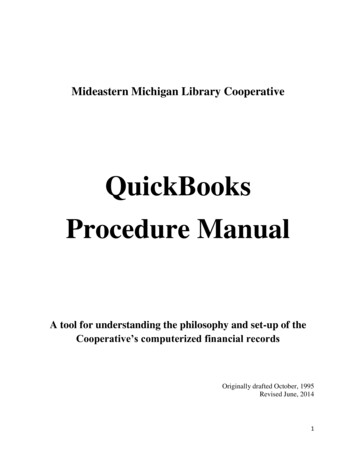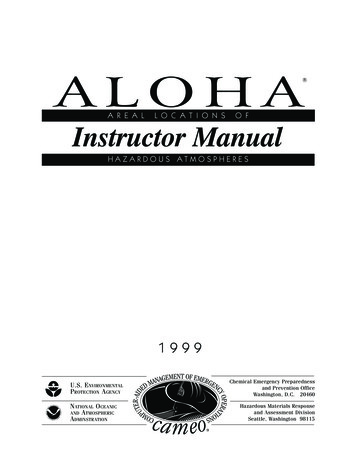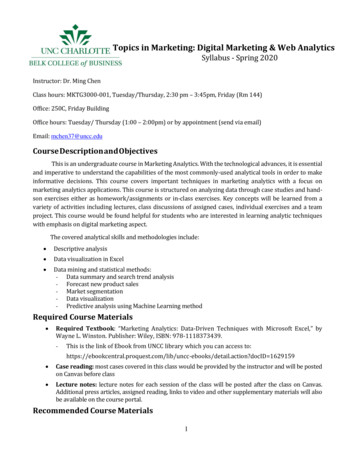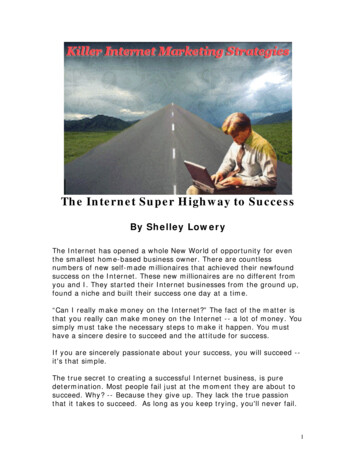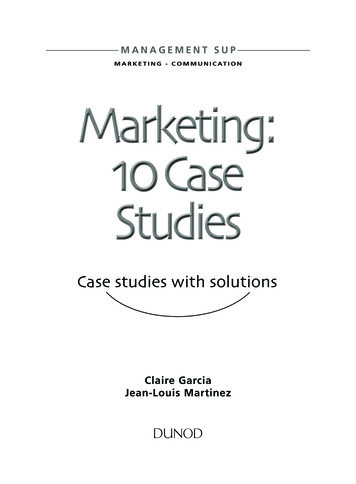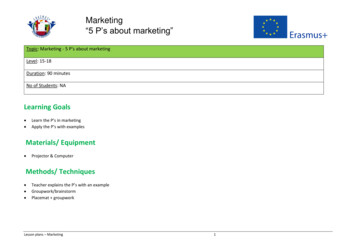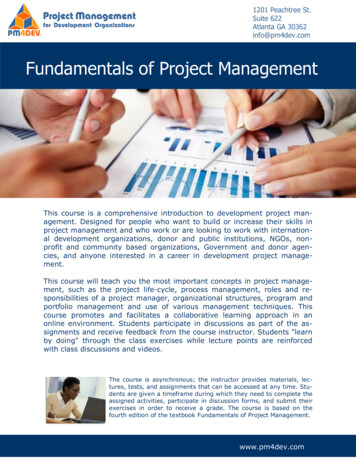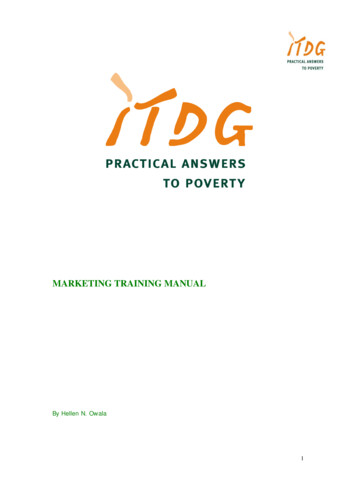
Transcription
MARKETING TRAINING MANUALBy Hellen N. Owala1
TABLE OF CONTENTSBACKGROUND AND OVERVIEW. 3MARKETING TRAINING GOALS .3SESSION ONE: LEARNING ABOUT EACH OTHER . 5SESSION TWO: INTRODUCTION TO MARKETING.10SESSION THREE: IMPORTANT COMPONENTS OF MARKETING .13SESSION FOUR: PRICING.17SESSION FIVE: PROMOTION .19SESSION SIX: CREATING MARKET MESSAGES .22SESSION SEVEN: SOLVING MARKETING PROBLEMS .25SESSION EIGHT: BUILDING MARKET LINKAGES.28SESSION NINE: DEVELOPING A MARKETING STRATEGY .30SESSION TEN: TESTING MARKETING MESSAGES AND PROMOTION MATERIALS .37SESSION ELEVEN: CONDUCTING A DEMONSTRATION.39APPENDICES.41APPENDIX I MARKETING PRACTICES FORM .41APPENDIX II MARKET TEST FORMS .45APPENDIX III HOW TO PLAY THE MARKETING GAME .49APPENDIX IV SOME MARKETING PROBLEMS.502
BACKGROUND AND OVERVIEWThese modules are aimed at helping small-scale entrepreneurs to improve theirbusiness productivity through better marketing. Many businesses start yet fewbusinesses survive. Effective marketing is the difference between failure andsuccess.This training is based on the experiences of the ITDG-EA-Energy Programme,Upesi Project activities. The project aim is to develop and market rural domesticstoves.It is written in consideration of the fact that many small-scale entrepreneursparticularly need basic marketing training to conduct successful business in therural areas. The modules help to communicate the concept, provide a practiceexercise and finally an opportunity to test the ideas on the ground depending onwhich business one is conducting.The manual will be used by organizations working with rural communities tostrengthen their marketing skills and to enable sustainable marketing of theirproducts and services.MARKETING TRAINING GOALS Understand the four components of marketing: Product, Price, Distributionand PromotionEvaluate how well the product or service meets the needs of customersDetermine the best price for the product or serviceSelect the best way to distribute the productCreate new ways to promote the businessIdentify ways to expand the businessSolve the specific marketing problems that ariseDevelop a marketing plan for a defined period of timeKey to experience sharing is the fact that with marketing training alone thedissemination is not automatically successful. But successful disseminationcomes also with good leadership and organization in the case of groups. Thusthe organizations working with communities need to realize that groups marketsuccessfully when their production, marketing earning is well streamlined. Thusalong this manual it will be useful to consider looking at the manual on“Crganizing Communitiesfor Success”, produced by the same author.3
INTRODUCTION TO THE MANUALThe manual is written from modules developed by the training team on thestoves commercialization project and the OEF international Small businessesbook.The manual consists of sessions which are in order, and each session has theobjective spelt out, the training materials and preparations required, and possiblediscussion questions. At the end of each session there is the facilitator’s notes tobe used for reference. It is important that the facilitator is able to revise thenotes in preparation for each session. Handouts have developed from these andneed to be given out at the end of the training session.Appendix V shows a summarized list of materials required before one sets offthis marketing training and it is important that the facilitator has all of them.Appendix VI has a few energizers to be used during this training.4
SESSION ONE: LEARNING ABOUT EACH OTHERObjective:To create a positive beginning, know each other better, builda team and share the training goals and plans.Methodology:Individual participationTraining Materials/Equipment Required:Felt pens, newsprints, notebooks, pens, pencils and rulers.Preparation Required:1.2.3.4.5.Write the training goals on a large paperCut the papers in required designsPrepare what to tell the participants during this sessionHave the programme schedule at handCut manila papers into 5x3 inch pieces (name tags)Time: 1hr 30 minContent:Step Ia) Agree on the language to be used during the training programmeb) Evaluate the sitting arrangements and discuss the possibilities of changingfrom time to time to suit the session.Step IIIntroduction of participants.Cut the shapes into two, distribute and ask people to find their partners. Theyneed to introduce each other and familiarize with any aspects of their lives theywant people to know. Give them time to introduce one another on the plenary.Ask each participant to write the name they wish to be called by during theworkshop.5
Step IIIAsk participants to define marketing. Summarize their definitions into one agreeddefinition. Post the four marketing components posters and ensure that theteam understands what they mean. Internalize the visual expressionsStep IVDistribute cards to the participants and ask each participant to write oneexpectation of the meeting and one problem that they face in their businesson separate cards.Step VAsk participants to paste the cards with their expectations and problems on thewall. Mount the big poster with training goals on the wall then ask theparticipants to match their expectations with the training goals.Agree on how important expectations that may not be covered during thesession will be covered (these could be covered during another trainingprogramme).Step VIDiscuss appropriate training methods with the team (Use the Facilitator’s notesbelow).Step VIIPresent the programme schedule and find out if there are questions. Keep theprogramme for the day written on newsprints and posted everyday on the walls.Step VIIIAgree with participants on the workshop normsDiscussion notes (for the facilitator) Is the session objective clearly understood?What do the participants think about the programme?Find out how prepared the team is to go through the trainingFind out what difficulties the participants themselves go through during the trainingIs the training environment conducive?6
7
Facilitator’s Notes Keep the training goals throughout the trainingKeep the group norms postedKeep 4 components of marketing postedBusiness is about constant interaction with partnerships (Business partners)Customer – buyer etcCustomer – service providerProducer – service provider – user etc.Definition of marketing and marketing conceptMarketing is a 4- step process, which aims at increasing sales and profits by concentrating ongiving customers what they need/want.STEP ONEUnderstand what customers need /wantSTEP TWODevelop a product which gives customers what they need/want.STEP THREEPromote the product to customers.STEP FOURKeep on improving the product (keep up with the customers)MARKETING CONCEPTThe concept holds that the key task of the business is to determine the needs/wants of thetarget markets (customers) and to adapt all the activities at delivering the desired satisfactionsmore effectively and efficiently than its competitors.CUSTOMERAnyone (individual or organization) with a need for a product or service which he/she is willing tobuy and has a purchasing power)Types of customersRetailers – Buy mainly from wholesaler and sell to the customersWholesalers - Buy product in bulk from producer and resell to the retailers and sometimes tofinal customersConsumers or end users. - Persons who use the products to satisfy their needsTo emphasize the concept, post some of the slogans below at the business place:“A customer is a King”“ A customer is the most important visitor”“ Have it your way”“You are the boss”What is a market?Physical place where buyers and sellers gather to exchange goods and servicesUseful tipsThe training programme is a problem -solving activityBeing adults, experience sharing will make a big contribution to what you come up with duringthe trainingThere will be no teacher since participants already know many things and can help each other8
For each session covered, participants should ensure that they apply it to the business they aredoing or they are planning to doBy the end of the training programme participants will have a new plan for marketing their product andperhaps a plan to expand their business.Key Training Methods Individual contributionsGroup discussionsRole playsField visitsAt the end of this session give handoutsa) Marketing Training Goalsb) Important Definitions of marketingExperience sharingIn this session the facilitator needs to ensure that all the definitions are examined in light of thebusinesses that the trainees are involved. After defining marketing e.g.Customers – after determining the customer, identify with the trainees the product they are selling andwho their customers are and what type of customers they are9
SESSION TWO: INTRODUCTION TO MARKETINGObjective:To understand the importance and challenges of small-scalebusinessesMethodology:Role play and group discussionsTraining materials /equipment required:Newsprints and felt pensPreparation Required:During the break before this session, ask for 8 volunteers. Explain to thevolunteers that they will be involved in a role-play in the next session. Explain tothem the role-plays and give them time to prepare.Time: 1 hourContentStep IIntroduce participants to the session.Define with the team what is considered on small scale-business. Ask them tolist some of the small-scale businesses they know.Tell them that they will watch 2 role-plays. Ask them to record the problemsfaced by small-scale businesses and strengths of small scale as depicted in thetwo role-plays.Step IIInvite group II to present their role-play.Invite group I to present their role-playStep IIIIn plenary ask the team to list the problems and importance of small scalebusinesses mentioned in the two role-plays.Record all the feedback on the newsprints.10
Step IVCompare the information recorded to those on the facilitator’s notes and addwhat has not been recorded then, summarize challenges and strengths of smallscale businesses. Ask the participants to discuss question 1 in groupsDiscussion Notes1. How can we make our small businesses survive? Or What are the possible solutions tochallenges faced by small scale businesses?2. What happens in your situations? What problems do your businesses face?3. Why do you think you face these problems?ConclusionsTo conduct a successful small-scale business, it is important to have a clearmarketing strategy and practical market plan. The training sessions in thismanual will:1.Help to improve marketing and solve marketing problems2.Help to teach marketing concepts for participants to use in their situationsFacilitator’s NotesMany times, small-scale businesses are largely practiced and they often face a number ofchallengesCharacteristics and examples of small scale businesses: Produce and sell in small scaleLess use of heavy machineryBelong to individuals and small groups and small associationsRole playDivide the volunteers into two groups and explain to them the following:Group 1: Challenges for Small scale BusinessesAssume the role of an entrepreneur. Discuss among themselves the problems faced by smallscale entrepreneurs. Practice to act this for presentation in the plenaryKey items to capture Product quality, acceptability, price and availabilityPackagingMethod of selling (how selling is done)Awareness and effective promotion of the productProfitability11
Maintenance (Problems easily eat away capital)Group II: Strengths of small-scale businessesTell them that they will discuss and act out the strengths of small-scale businesses. Practice toact this for presentation in the plenaryKey items to capture Requires minimum capital to start Easy to manage, monitor and control Quality control is easy Can be practiced anywhere including rural areasAsk the participants to write their problems and keep them for the handout ‘introduction tomarketing - session on problem solving’. Effective marketing involves dealing with the problemsfaced.EXPERIENCE SHARINGSmall businesses need to be run as business in order to surviveFor development activities – marketing aspect of interventions is importantSustainable marketingSustainable marketing is obtained by allowing the commercial elementProfitableCarried out by independentIndigenizedImproved levels of skills We have to clearly develop the marketing strategies and implement 12
SESSION THREE: IMPORTANT COMPONENTS OF MARKETINGObjective: To understand the four components
Marketing is a 4- step process, which aims at increasing sales and profits by concentrating on giving customers what they need/want. STEP ONE Understand what customers need /want STEP TWO Develop a product which gives customers what they need/want. STEP THREE Promote the product to customers. STEP FOUR Keep on improving the product (keep up with the customers) MARKETING


